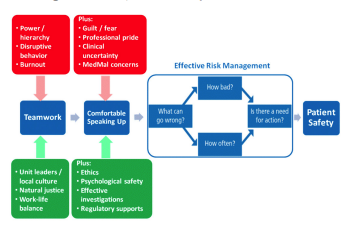Patient Safety
Overview of Issue
There is an integral alignment between risk management and patient safety. Risk managers are tasked with fostering a patient safety culture to ensure each patient care experience is a safe one.
Key Points
- Patient harm continues to be a serious public health issue that can be prevented or mitigated.
- Advancement of patient safety requires a shift from reactive, piecemeal interventions, to a total system approach to safety.
Things to Consider
Background
- Patient harm continues to be a serious public health issue that can be prevented and/or mitigated. Significant harm occurs in 1 in 18 hospital admissions (Canadian Institute for Health Information, Canadian Patient Safety Institute, 2016).
- The discipline of patient safety is still early in its evolution, and improving patient safety is a complex problem that requires work by diverse disciplines to solve.
Patient Safety from the System Perspective
- The National Health Service’s Incident Decision Patient safety is about providing a safe environment for patients in order to mitigate the possibility of failure by humans, technology, or breakdowns in systems leading to patient harm.
- Dr. James Reason has helped healthcare leaders to understand how accidents occur and the need to look at healthcare harm from a systems perspective. His work focuses on the models of accident causation used for risk management of human systems.
Leadership’s Role in Establishing and Sustaining a Patient Safety Culture
- Improving safety requires a large-scale organizational culture shift that enables and prioritizes safety as a strategic priority that is consistently endorsed by the board and senior team.
- Piecemeal interventions to improve patient safety culture have been shown to be inadequate; improving patient safety culture requires simultaneous interventions that enable, enact and elaborate (learn) at all levels (Singer & Vogus, 2013).
Partnering with Patients and Families for the Safest Patient Care
- Patients and their families have become much more aware of medical error and are demanding action and greater openness. Healthcare organizations are partnering with patients from the bedside to the boardroom in decision-making to create better outcomes.
Patient Safety across the Care Continuum
- As evidenced in HIROC claims, there are certain risks that are common across the care continuum (e.g. patient deterioration, transitions in care, and follow-up with diagnostic errors).
- Risk managers need to identify and understand the potential and actual risks specific to each unique patient population.
Fostering Teamwork and Speaking Up to Improve Patient Safety
- Risk managers play a key role in: ensuring a safety culture that acknowledges healthcare risks; promoting injury prevention for both patients and staff; encouraging the reporting of errors and near misses without fear of reprisal; conducting system analyses which may result in quality improvements; fostering teamwork and communication; and adopting patient safety principles based on human factors research.
- With effective teamwork, healthcare providers are comfortable speaking up. When this occurs risk is identified, assessed and managed ultimately affecting health outcomes and patient safety. The following evidence based model developed by HIROC depicts the interplay between teamwork, risk management and patient safety:

Patient Safety Metrics that Mitigate Risk
- Each healthcare organization will develop and track patient safety metrics (e.g. falls, medication errors, pressure ulcers). Sometimes, these are reported publicly.
Support for Healthcare Workforce
- Workplace safety, morale, and wellness are essential requirements to providing safe care. It is imperative that members of the healthcare workforce be supported. Attention must be directed to both physical harm (i.e. physical injury, violence in the workplace, stress related illness) and emotional harm (i.e. disrespectful behavior, intimidation and verbal abuse).
The Role of Technology to Optimize Patient Safety
- It is essential to identify and measure the unintended consequences and harmful incidents related to health information technology (IT). Equally important is the need for vendors and users to be transparent about health IT safety hazards and the implementation of best practices to mitigate risk.
References
- Canadian Institute for Health Information, Canadian Patient Safety Institute. (2016). Measuring patient harm in Canadian hospitals.
- National Patient Safety Foundation. (2015). Free from harm: Accelerating patient safety improvement fifteen years after To Err is Human.
- Singer S, Vogus T. (2013). Reducing hospital errors: Interventions that build safety culture. Annu Rev Public Health. 34:373-396.